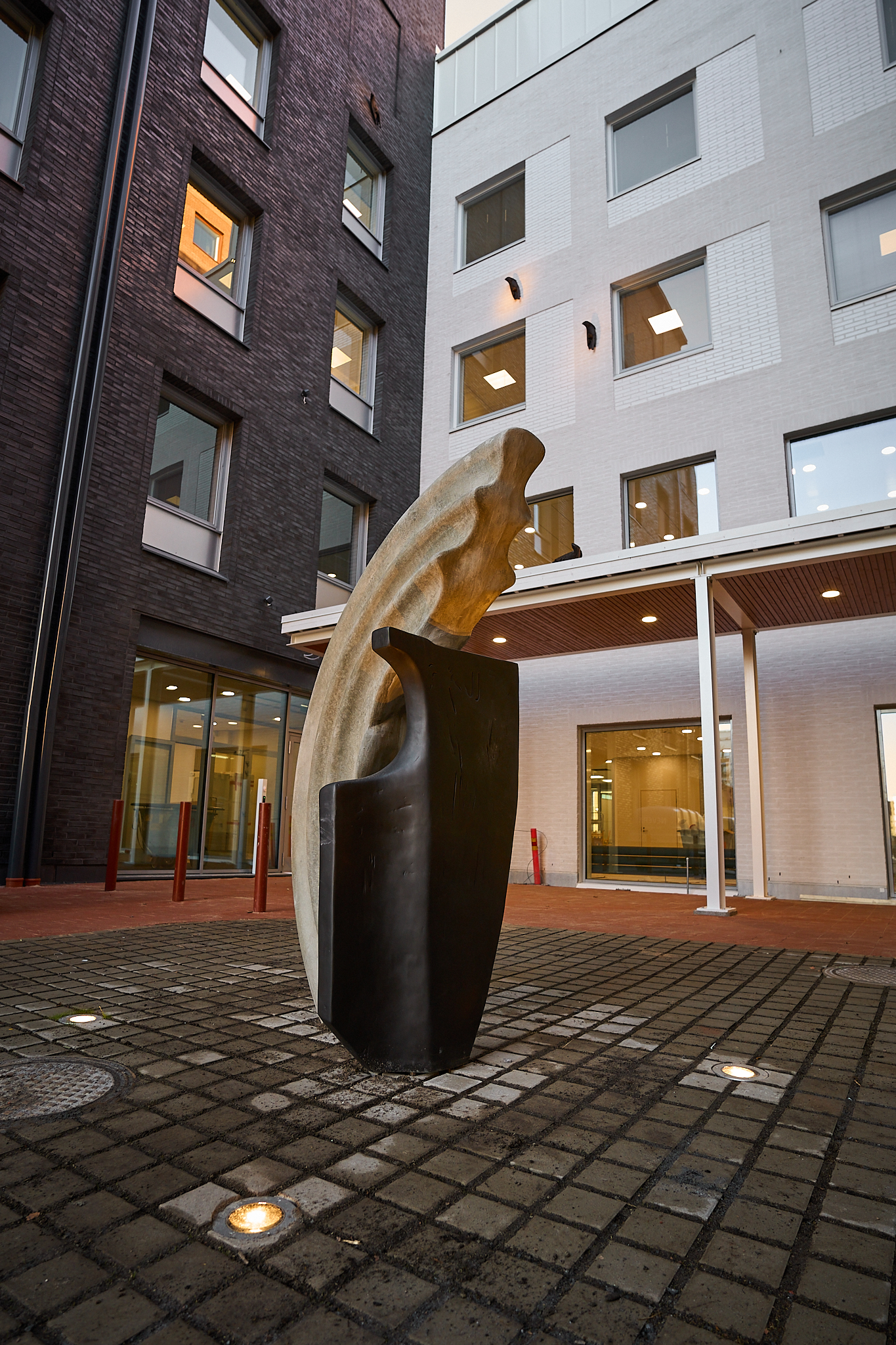Art around the railway station
Arja Kärkkäinen Birth Stone
Arja Kärkkäinen’s Birthstone, located in the square in front of the Aallokko Family Service Centre, is a monument to parenthood: to the support and limits offered by family relationships and parenting. The name Birthstone refers to the living ones, living, and to the birth of life.
The artwork can be viewed from the level of the paving and the upper floors of the adjacent buildings.
The shapes of the artwork resemble cell tissue. The main material of the work is concrete. Between the oval and undulating shapes, the artificial concrete strips form the boundaries of the tissue, with circular stones with small copper details in the center. The cells are filled with curved dice stones.
The oval tree planting basin in the middle is also a part of the work and an important visual element, differing in shape from the other planting basins in the square. The tree growing in the basin is oak.
The artwork is made with Vihdin Betoni Oy.
Arja Kärkkäinen (b. 1986) is a Helsinki-based visual artist. Kärkkäinen works mainly with video and sculpture. Her works reflect social themes, such as inclusion and non-verbal agreements within and between people in society. She has made public works in several locations in Finland and her works belong to several collections. Birthstone is part of a series of works, of which the previously completed piece Birthstones (2019) is in Nurmijärvi Library.
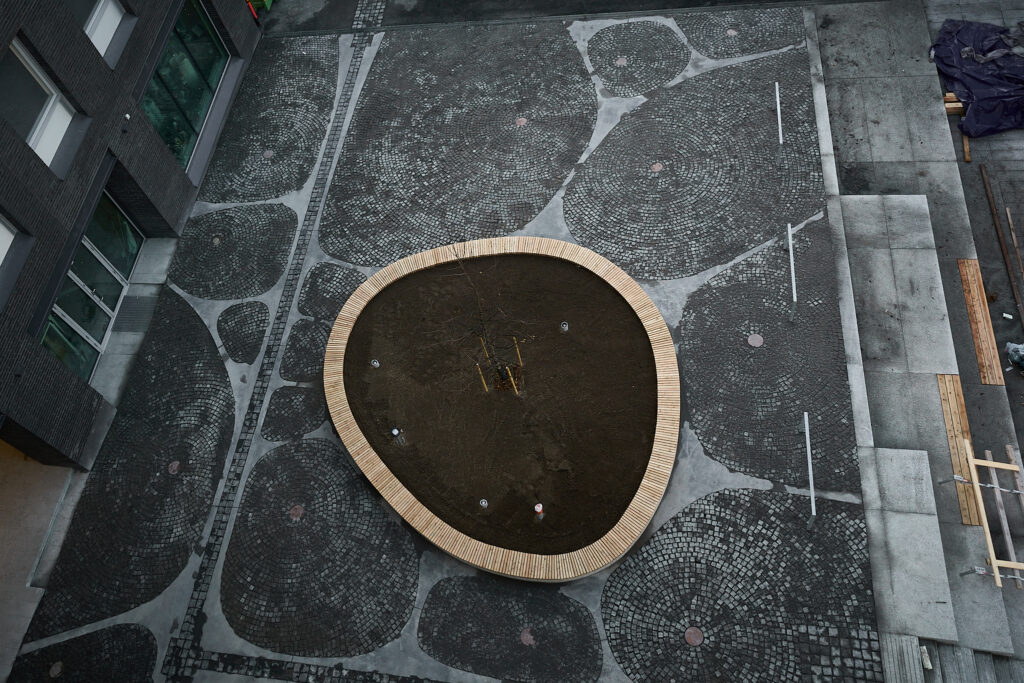
Juhana Moisander Platform 0
Juhana Moisander’s artwork Platform 0 is located on two external walls of the Seipark parking garage. The artwork has been created by perforating a photograph-based image in weathering steel elements (COR-TEN) on the facade of the building. The technique creates a raster image in which the size and number of holes draw out the image, creating variations of light and shadow. The work also includes a clock on the wall facing the platform.
The artwork is based on the shared history of Seinäjoki and the railway. As an innovation, the railway was revolutionary for society and culture. The development and growth of the City of Seinäjoki has been largely based on the railway and its central location at the crossroads of the tracks.
Railway stations are full of memories and events with people at the focus point. Railway stations and railways are places of departure and arrival, of encounter and, of work. A railway station is a place of waiting and excitement. Platform 0 represents the very place of departure and arrival, and the number 0 can be seen as the intersection between past and future: from zero one can move linearly both back and forwards.
The artwork features people of different ages from different eras, a horse, and a station clock. The model for the horse is Akaasia, an accomplished trotting horse who lives in Kurikka. The horse symbolizes the historic change brought about by the railway; the name “iron horse” was used when traditional horsepower was replaced by steam locomotives. The horse is also a reference to the agricultural region of South Ostrobothnia, where Seinäjoki is located. The station clock is a reference to the Könni family of Ilmajoki and its traditional clock design. It also refers to the time, timetables and passage of time that are present at the railway station.
The people in the artwork are the artist’s imagination of people who may have passed through Seinäjoki railway station at some point in their lives. The pictures of the people are based on real photographs taken in a photo studio in Pyhälahti, selected by the artist from the archives of the Lapua Museums. The artist’s intention has not been to create portraits or historical documentation of individuals, but to evoke thoughts, feed the imagination, and create an atmosphere. The way the image stands out from the steel is influenced both by the prevailing light conditions outside and by the lighting inside the parking garage: sometimes the figures stand out as hazier, like distant ideas, and at other times they appear more clearly.
The clock has been made by Suveko Oy. The perforated images on the steel elements have been modeled and manufactured by Trutec Oy.
Juhana Moisander (b. 1977) is known for his media works in which the relationship between sound, image, and space forms an atmospherically coherent whole. His works have been shown in several domestic and international exhibitions. His public work Justitia (2020) is in the Lappeenranta House of Justice.
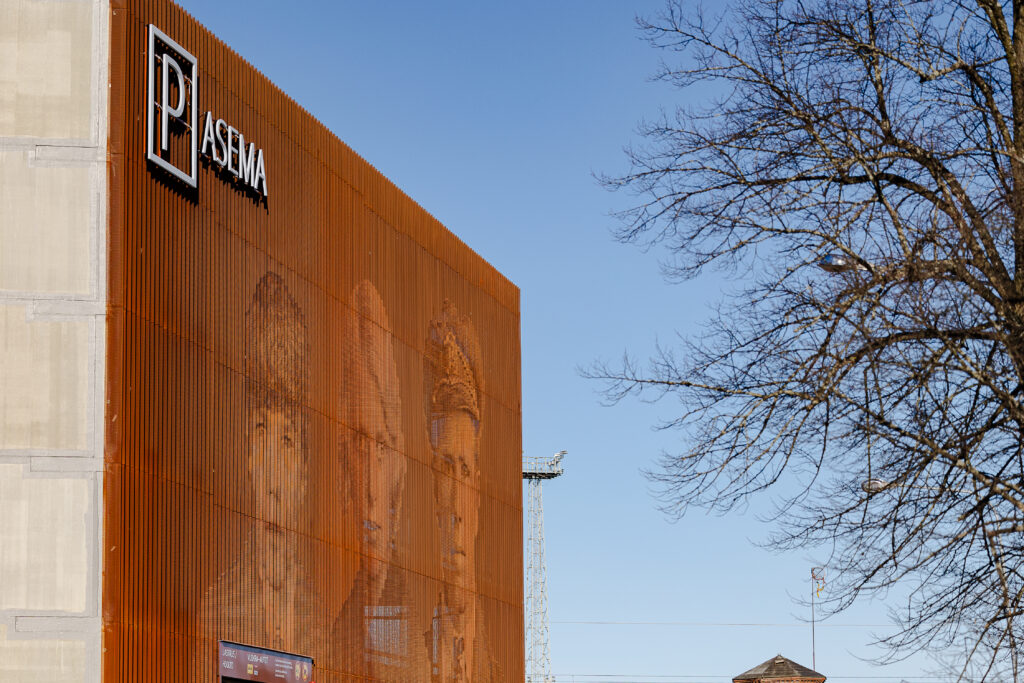
Marjukka Korhonen Rabbit Hole and Ferris Wheel
Marjukka Korhonen’s artwork Rabbit Hole and Ferris Wheel is located in the station tunnel. The work consists of a cloud-like, translucent mural, bronze and aluminum reliefs, and light rails on the walls. The light rails are programmed to change so that the work is constantly changing for the viewer.
The title of the artwork describes both the underpass tunnel itself as a place and the attempt to transform it into a platform for imagination and dreaming about travel. The artwork brings human scale, surprising elements, and a feeling of safety to the tunnel.
The cloud-like paintings on the walls are colour areas where colours mix. The paintings form continuity and add rhythm to the tunnel. The lights on the tracks turn on and off in time with the early train timetables. The relief that resembles a human figure, The Station Manager, oversees all this and sends off little birds, which take flight, some perhaps close by, others far away into the world. Local birds and some more exotic species symbolize the start of a journey, travel, and the opening of the world by railroads. In the mirrored section of The Station Manager, the viewer can mirror oneself and their surroundings.
The mural of the work was created in collaboration between the artist and ART-Betoni Oy. The castings of the reliefs were made by Herttoniemen taidevalimo.
Marjukka Korhonen (b. 1968) is a sculptor and public art professional. Her work ranges from individual sculptures to large-scale public art projects. Her work often focuses on human figures from different communities, such as family, friends or work communities. In her projects in urban spaces, Korhonen is particularly interested in the relationship between people and the built environment.
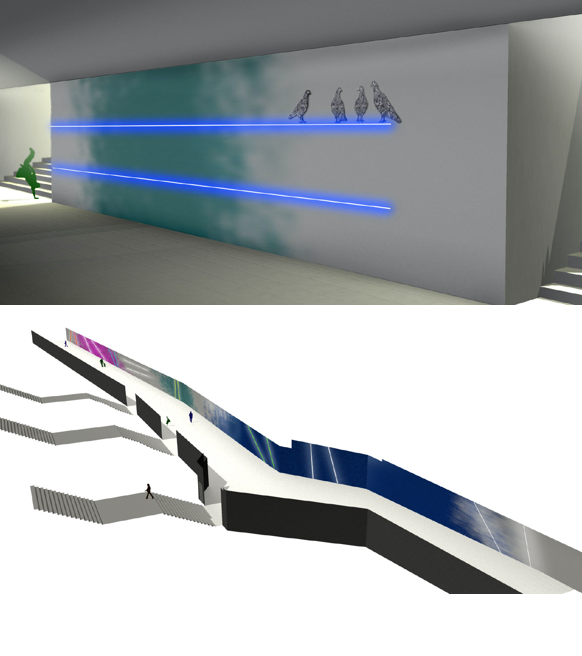
Pia Männikkö Stolon
Pia Männikko’s sculpture Stolon in the lobby of the Aallokko Family Service Centre is inspired by sprawling plants that are among the most effective ones to spread in the nature. The artist got the idea for Stolon while weeding flower beds in her garden. The inspiration for the work is the ground ivy, which spreads enthusiastically. When one branch or growth direction breaks off, the plant tenaciously grows a new sprout to replace the old one. Stolon refers to the many aspects and stages of human life: learning new things, seeking and finding direction, continuums of life, and striving forward.
The artwork has been designed with the Family Service Centre’s child clients in mind: the bright colours and its structure consisting of small pieces resemble Lego blocks, and the light reflected from the ceiling through the flowers casts light and shadow on the walls of the lobby.
The sculpture consists of a stele made of bent steel tubes and steel flowers and leaves attached to it. The leaves have been modeled on the ground ivy. The flower designs are combinations of different plants and sun symbols. The different shades of green on the body and leaves enliven the work and emphasize its playfulness. The scuplture is attached to the opposite wall of the main entrance, from where it spreads out over a large area in the lobby up to the upper floors.
The art work has been made by the Seinäjoki-based company Kaaritaivutus Kumpula Oy.
Pia Männikkö (b. 1971) is a multidisciplinary visual artist working with textiles, clay, everyday objects, video and photography. Her work often has a strong relationship with space, embodiment and natural phenomena. Männikko’s art has been shown in several exhibitions in Finland and abroad.
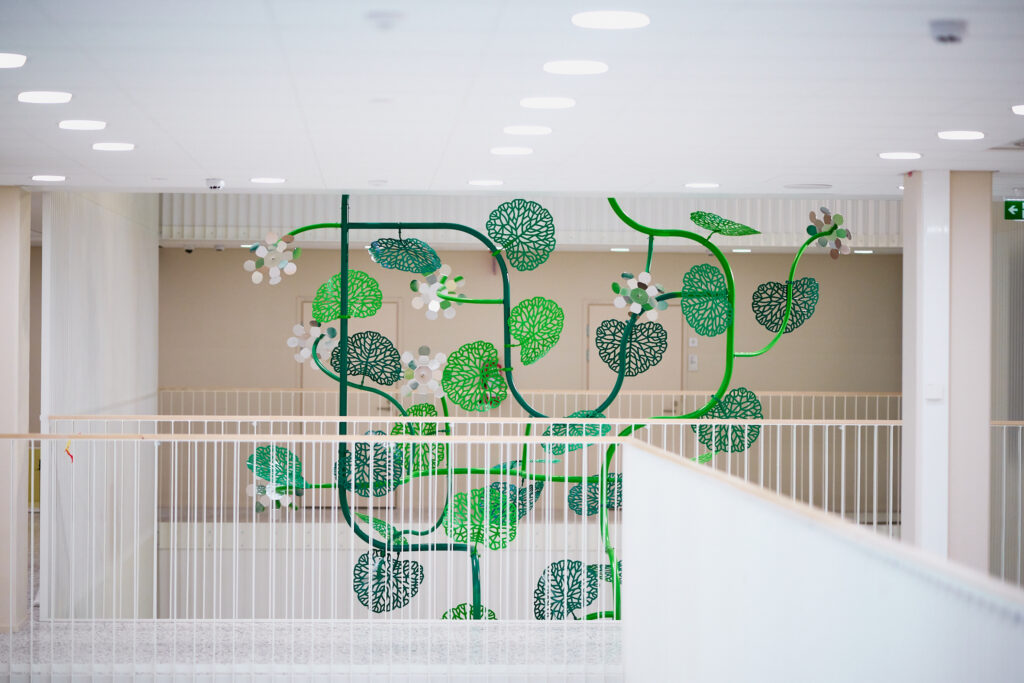
Tiina Raitanen Those Who Wait and Those Who Arrive
Tiina Raitanen’s work Those Who Wait and Those Who Arrive is in the courtyard of the Aallokko Family Service Center. The work consists of two parts. The larger Those Who Wait is located on the grassy area in the courtyard, while the smaller, four-part Those Who Arrive is attached to the outside wall and canopy of the Family Service Centre.
The artist’s idea for the work came to life when she visited Seinäjoki in the spring of 2022 and explored the city and the surroundings of the railway station. She examined random objects that were lying here and there and selected the most interesting shapes to take with her. Objects that end up in a certain place at a certain time interest the artist and refer, in her mind, to the randomness of life. The objects found in and around the railway station were molded in bronze and concrete to serve as models for works of art.
The simplified sculptures, as their names suggest, depict waiting and arriving. Waiting is associated with things like departure on a journey, returning home, or waiting for an appointment. A longer wait makes the body look for a post, a chair, or a railing, something to lean on. The Those Who Wait sculpture illustrates this: a curved concrete piece rests on a lower bronze section. The wavy lines of the sculpture’s arch resemble circles on a ring, like the paths we take in our lives. On the back of the sculpture are objects cast in bronze. They are signs and traces of a life lived.
The four-piece work The Ones Who Arrive is on the outside wall and canopy of the Aallokko Family Service Centre. The objects found by the artist have been given a winged or leafy shape in the sculptures. The work depicts the arrival at a destination or loved ones, the arrival of news or contacts. The pieces are scattered throughout the building as if tossed by the wind.
The artwork has been made by BetoniPallas Oy, Vihdin betoni Oy and Herttoniemen taidevalimo Oy.
Tiina Raitanen (b. 1983) works with different materials and techniques. She often uses random objects she finds in her environment. Raitanen’s art has been exhibited in Finland and abroad. His large-scale outdoor sculpture Luettelo was completed in 2022 in front of the European Chemicals Agency (ECHA) in Munkkisaari, Helsinki.
